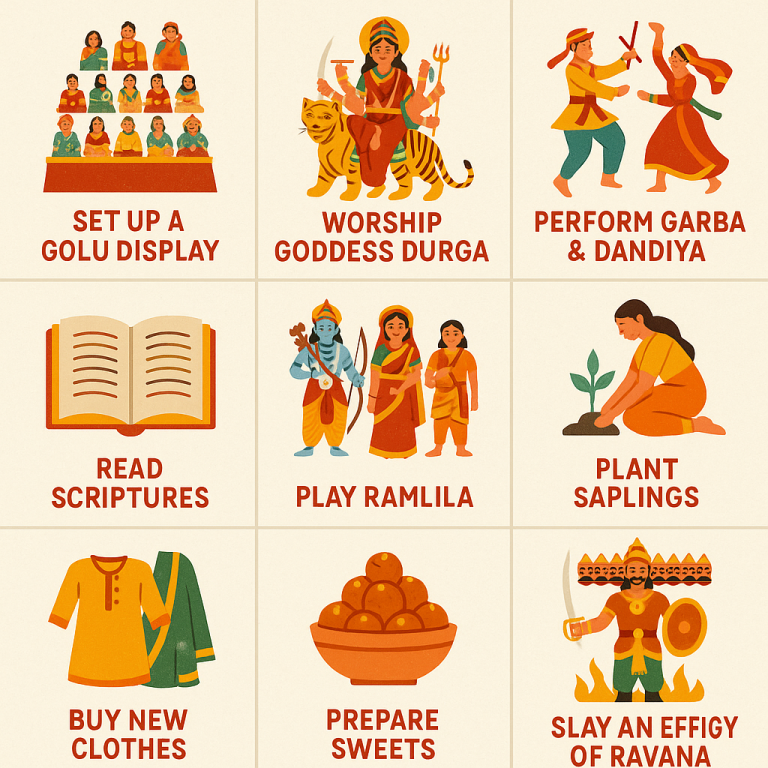
Anti-Aging Treatments in Banjara Hills, Jubilee Hills That Actually Work: Latest Trends in 2025 Aging is a natural process that...

Dussehra (also known as Vijaya Dashami) marks one of the most revered and joyous periods in the Indian festival calendar. The nine days leading up to the final day are rich in rituals, devotion, myth, community, and a celebration of the victory of good over evil. Whether you observe Navratri strictly, loosely, or somewhere in between, these nine traditions can help you experience Dussehra in a deeper, more connected way. Let’s explore each tradition in detail, so you can make every day count.
During the nine days, devotees worship the nine avatars of Goddess Durga Shailaputri, Brahmacharini, Chandraghanta, Kushmanda, Skandamata, Katyayani, Kalaratri, Mahagauri, and Siddhidatri. Each day is dedicated to one of these forms, each symbolizing distinct virtues, such as courage, compassion, knowledge, or serenity.
A major highlight in many regions is Ram Leela’s dramatic retellings of Lord Rama’s life, especially the final battle with Ravana. Alongside, there are folk songs, local dance forms, and theatrical performances.
Visuals matter in festivals. Decorations make the atmosphere festive, signal collective celebration, and awaken senses.
Festivals thrive in community spaces. Fairs (melas) are where neighbors meet, children play, artisans display skill, and food stalls tease taste buds.
The climax of Dussehra is the burning of effigies, most often of Ravana, Meghnath, and Kumbhakarna, accompanied by loud fireworks. It’s symbolic, dramatic, cathartic.
Festivals are as much about relationships as rituals. Dussehra offers an opportunity to deepen family bonds and pass on stories.
Dussehra isn’t just a celebration of triumph; it’s also a time to share, give, and uplift. The virtue of compassion is central to many of its stories.
Beyond the external rituals, Dussehra is deeply symbolic of good over evil, light over darkness, and spiritual growth. The nine days leading up to the tenth can be used for inward growth.
The nine days of Dussehra are far more than a festival; they are a journey. A journey of devotion, purification, community, and renewal. By embracing these nine traditions of worship, fasting, feasting, culture, decor, fairs, effigy burnings, family, charity, and reflection, you get to live the spirit of the festival fully.
This year, as the lamps glow, the stories are told, and the effigies blaze, may you find not just celebration but transformation. Happy Dussehra from all of us at Twaccha. May your days be filled with light, virtue, and purpose!

Anti-Aging Treatments in Banjara Hills, Jubilee Hills That Actually Work: Latest Trends in 2025 Aging is a natural process that...

Best Skin Specialist in Jubilee Hills, Banjara Hills – Your Skin’s True Care Starts at Twaccha Have you Remembered When...

Best Skin Clinic in Jubilee Hills, Hyderabad: Why Twaccha Stands Out If you’re searching for the best skin clinic in...
Dussehra or Navratri honors the nine forms of Goddess Durga, symbolizing the victory of good over evil. Each day is dedicated to a different form.
West Bengal celebrates Durga Puja with grand pandals, Gujarat dances Garba, Tamil Nadu sets up Golu, and North India hosts Ramleela shows.
Fasting is a personal choice. Many observe partial fasts or simply eat sattvik food. The main aim is spiritual discipline.
Use natural rangoli colors, clay idols, avoid plastic decorations, and support local artisans for your festive needs.
Yes! Involving children in decorating, storytelling, or attending community events makes the festival meaningful for the next generation.
Twaccha Skin Clinic specializes in skin and hair treatments. We offer services like acne treatment, anti-aging solutions, and skin rejuvenation. We focuses on using advanced techniques and personalized care to help clients achieve healthy, glowing skin. We also provide consultations to address individual skin concerns.